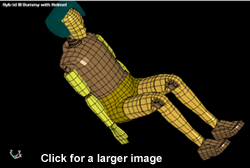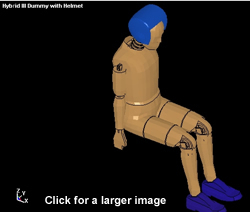A soldier’s ability to survive a mine blast greatly improves if armored vehicles are equipped with energy-absorbing seats, according to recent studies by a University of Cincinnati scientist.
Working with the University of Nevada at Las Vegas, Professor Ala Tabiei developed and evaluated a new seat design for personnel carriers and other non-tank vehicles that mitigates an explosion’s force inside the vehicle.
“These findings are particularly exciting, because they could contribute to a whole new way of protecting soldiers’ lives,” said Tabiei, an associate professor of aerospace engineering and engineering mechanics at University of Cincinnati.
The blast from anti-tank mines or improvised explosive devices, commonly called IEDs, can load the floor of the personnel carriers or other non-tank vehicles. When this happens, shock waves transfer from the floor to the seats to the occupants, often with such force that it can crush the occupants and severely injure or kill them. Some U.S. Army vehicles have various forms of protective seating that absorbs some of these acceleration pulses, or shock waves; this study is part of an effort to update vehicles that do not have such protection, as well as refining those that already do.
 Instead of bolting the seat directly to the floor, Tabiei designed a seat attached to steel rails encased in aluminum tubes. Computer simulations showed that the force of a mine blast now moves from the floor to the tubes, crushing them in the process. Ultimately, the final design reduces the amount of force being transferred to passengers inside the vehicle to well within levels the body can withstand.
Instead of bolting the seat directly to the floor, Tabiei designed a seat attached to steel rails encased in aluminum tubes. Computer simulations showed that the force of a mine blast now moves from the floor to the tubes, crushing them in the process. Ultimately, the final design reduces the amount of force being transferred to passengers inside the vehicle to well within levels the body can withstand.
He first created mathematical formulas that represent different aspects of the vehicle. Next, he used special software, LS-DYNA 3D, to create a computer model of the vehicle, including seats, tires and human prototypes, and translate the formulas into a simulation. That’s when he turned to the high performance computing resources at the Ohio Supercomputer Center in Columbus.
 Tabiei perfected the simulation by running his data-intensive model more than 500 times on the Ohio Supercomputer Center’s Intel Itanium2 computer cluster.
Tabiei perfected the simulation by running his data-intensive model more than 500 times on the Ohio Supercomputer Center’s Intel Itanium2 computer cluster.
Once Tabiei ensured the model accurately simulated the force and injuries caused by an explosive force, he could reliably test and modify the designs for energy-absorbing seats without having to build and evaluate multiple individual prototypes.
“Many fatalities happen because of the acceleration pulses, not because of a direct hit from an exploding device,” Tabiei said. “With an energy absorber between the floor and the seat of the occupant, we can start to mitigate the shock wave and save lives.”
The numerical analysis and high performance computing provided by the Ohio Supercomputer Center are reliable, faster and far less expensive alternatives to conducting full-scale, destructive tests.
The Army Research Laboratory is combining the results of this study with the results of other relevant research being conducted by government and other personnel. The total results will factor into design decisions for current and future vehicles.
 Tabiei earned a doctorate in aerospace engineering and a master’s degree in mathematics from the University of Cincinnati and a bachelor’s degree in mechanical engineering from Wichita State University. His research interests include impact dynamics and numerical methods used to study structural mechanics.
Tabiei earned a doctorate in aerospace engineering and a master’s degree in mathematics from the University of Cincinnati and a bachelor’s degree in mechanical engineering from Wichita State University. His research interests include impact dynamics and numerical methods used to study structural mechanics.
This study was supported by the Army Research Laboratory at Adelphi, Md., through its Soldier's Objective Force Electronics Reliability and Survivability Technology Program (SOldier FERST) program and was directed by the University of Nevada at Las Vegas.
Ohio Supercomputer Center: Celebrating 20 years of service, the Ohio Supercomputer provides reliable high performance computing and high performance networking infrastructure for a diverse state and regional community including education, academic research, industry, and government. OSC promotes and stimulates computational research and education to enable the state to achieve its aspirations in information systems and advanced technology and industries. For additional information, visit www.osc.edu.